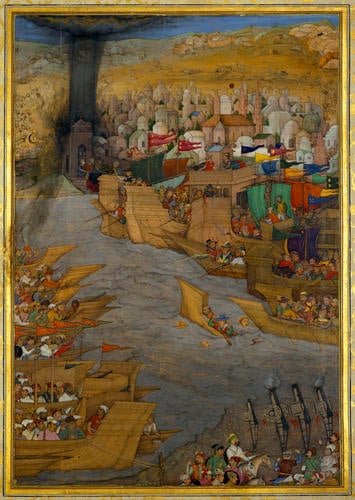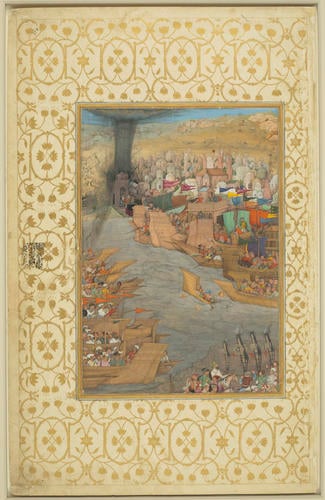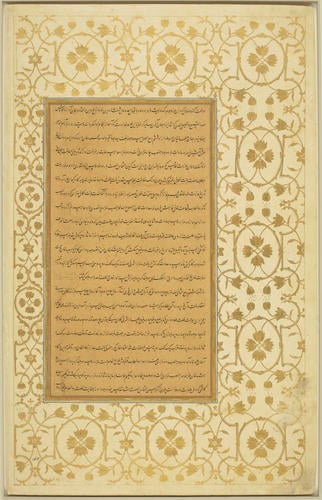The Capture of Port Hugli (June-October 1632) c. 1635 - 1650
Painting in opaque watercolour including metallic paints. | 34.1 x 23.5 cm (image) | RCIN 1005025.u

Mughal artist
Master: Padshahnamah ?????????? (The Book of Emperors) ?? Item: The Capture of Port Hugli (June-October 1632) c. 1635 - 1650

Mughal artist
Master: Padshahnamah پادشاهنامه (The Book of Emperors) Item: The Capture of Port Hugli (June-October 1632) c. 1635 - 1650



-
Padshahnamah fol. 117r
(plate 20)
The explosion of a magazine during Hugli campaign (June-October 1632) when Shah-Jahan’s army attacked the Portuguese trading settlement.
The Portuguese established a trading centre at Hugli, close to Calcutta in north-east India, in the second half of the 16th century. Its proximity to the Mughal port of Satgaon was the cause of aggravation to Shah-Jahan and culminated in an all-out Mughal attack in 1632.
Hugli is depicted with a large church with tall spires at its centre and the inhabitants all have red or fair hair and wear European coats and hats; and the women wear jewels and their hair up in a European fashion. The inhabitants are shown loading their boats to escape downriver, but the Mughals have blocked their route by ships roped together (on the left), a tactic said to have been suggested by Martin Alfonso, a Portuguese soldier who had defected to the Mughals. The soldiers in the boats carry guns, canon, and bows and arrows, and fly the Mughal flag. One of the Portuguese vessels has sunk, and its passengers are being recused by the crew of a nearby boat.
In the background is a nim-rang (half colour) scene, painted in whites, greys and browns, depicting the Mughal encampment and groups of soldiers with their elephants, camels, horses and oxen. A Mughal mine explodes in the upper left casting dark shadows over the surrounding area, and Mughal soldiers are shown approaching the city from behind. A Mughal commander with his sword drawn and wearing a gold helmet gives the orders. The black pigment of the mine was later smudged and wiped down the left of the painting, onto the manuscript’s border and fingerprints remain, presumably belonging to the person who attempted to fix the damage.
Bibliography:
Milo Beach and Ebba Koch, King of the world : the Padshahnama, an imperial Mughal manuscript from the Royal Library, Windsor Castle, 1996
Saqib Baburi, Beyond the Akbarnamah: Padshahnamahs and Official Regnal Chronography for Shah-Jahan Padshah (r. 1037/1628-1068/1658), 2010.Provenance
Illustration from a Padshahnamah manuscript formerly in the Mughal imperial library and acquired by Asaf al-Dawlah, Nawab of Awadh, c.1780-90; presented by Saadat Ali Khan, Nawab of Awadh, to George III via Lord Teignmouth in June 1799.
-
Creator(s)
(artist)Acquirer(s)
-
Medium and techniques
Painting in opaque watercolour including metallic paints.
Measurements
34.1 x 23.5 cm (image)
58.4 x 37.0 cm (page dimensions)
Category
Alternative title(s)
The Capture of Port Hoogly (June-October 1632)







